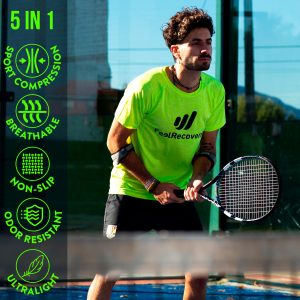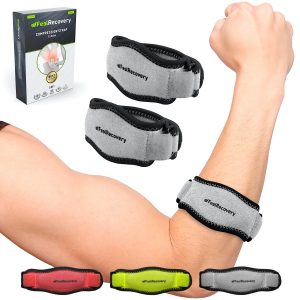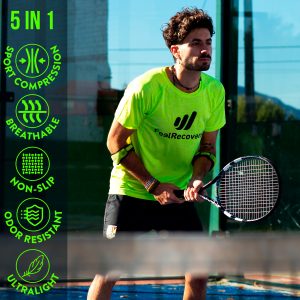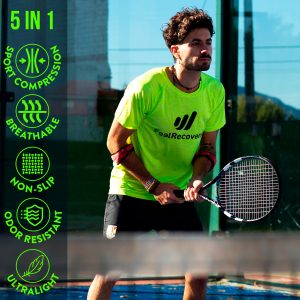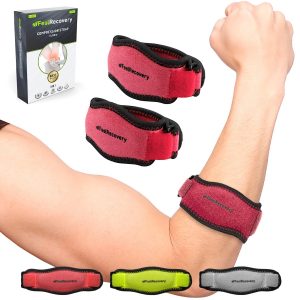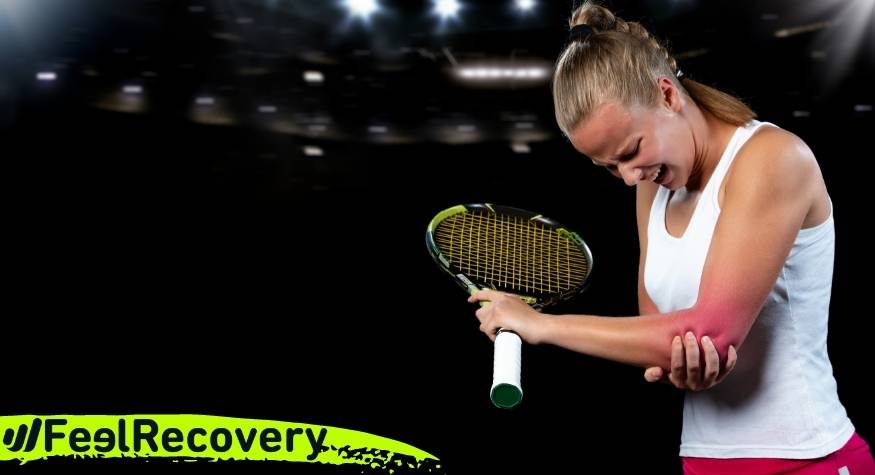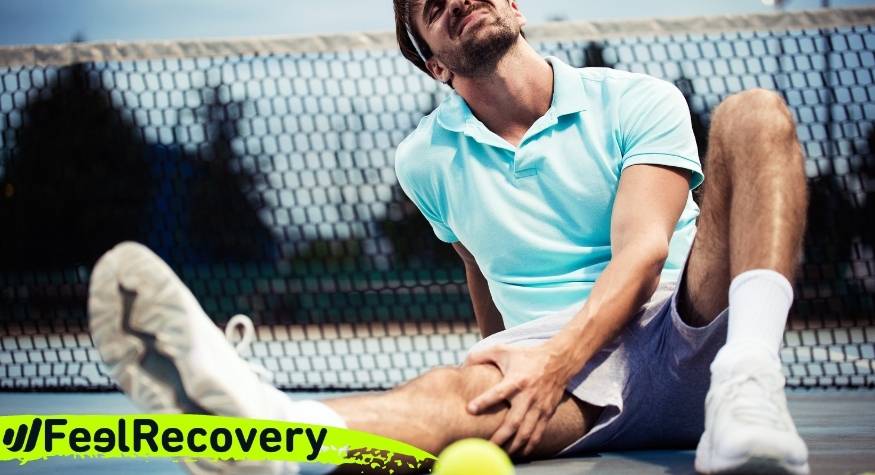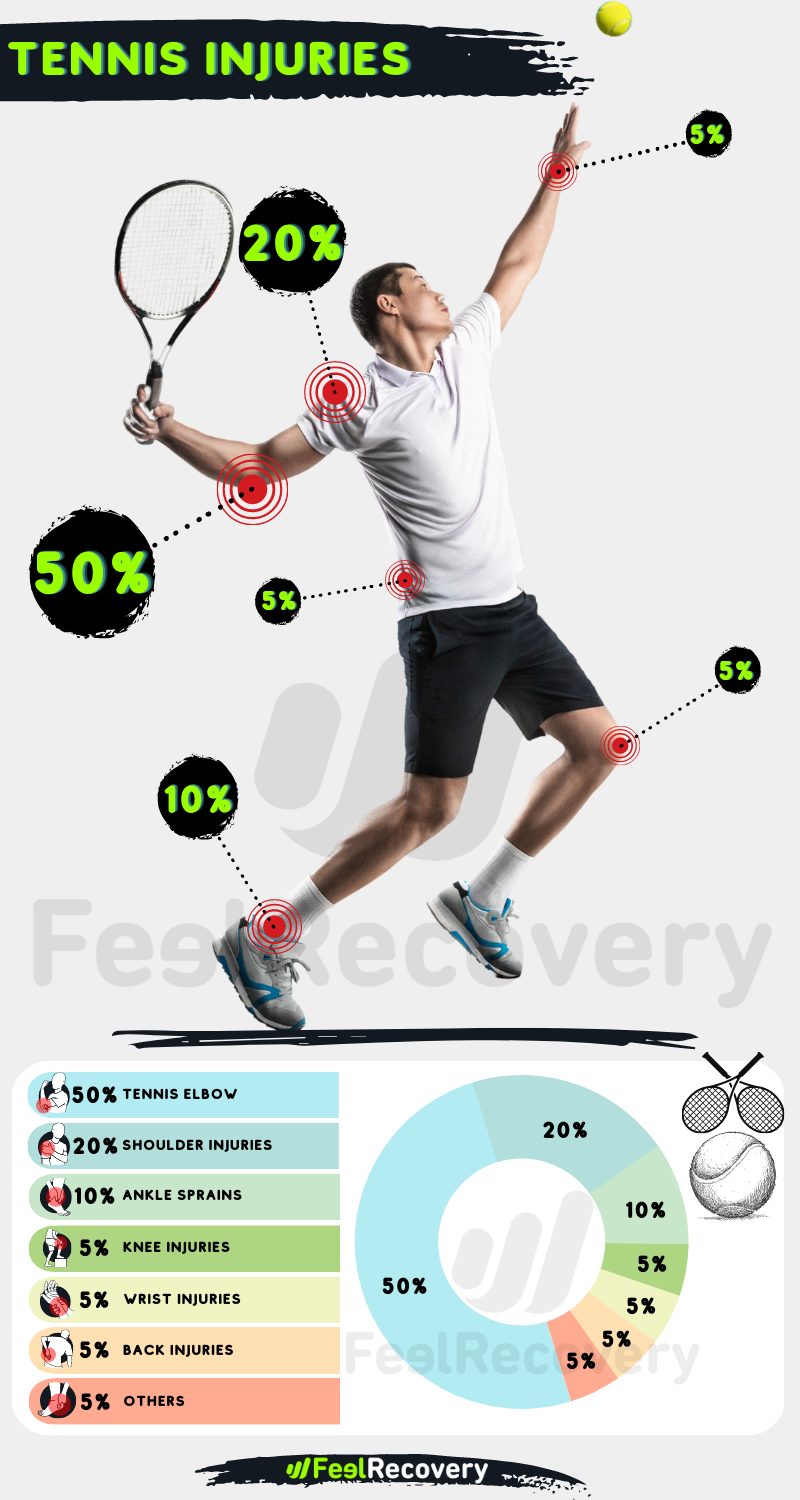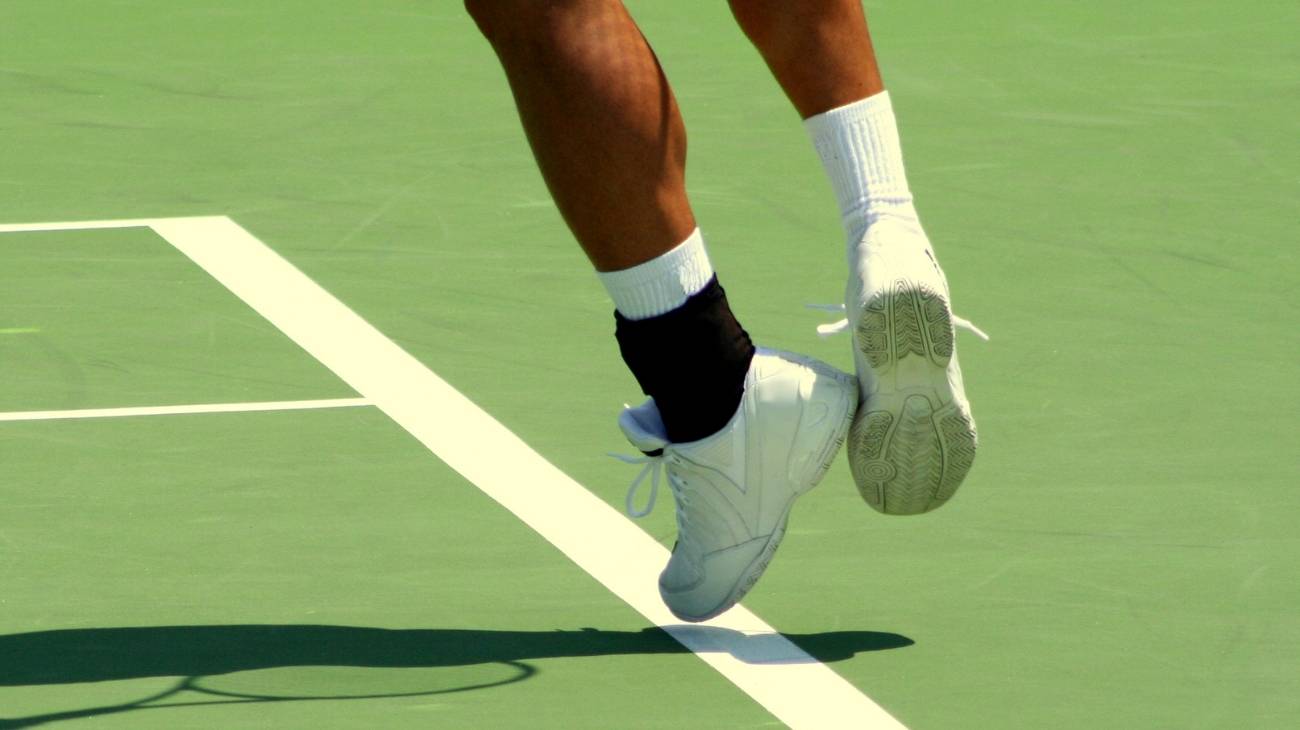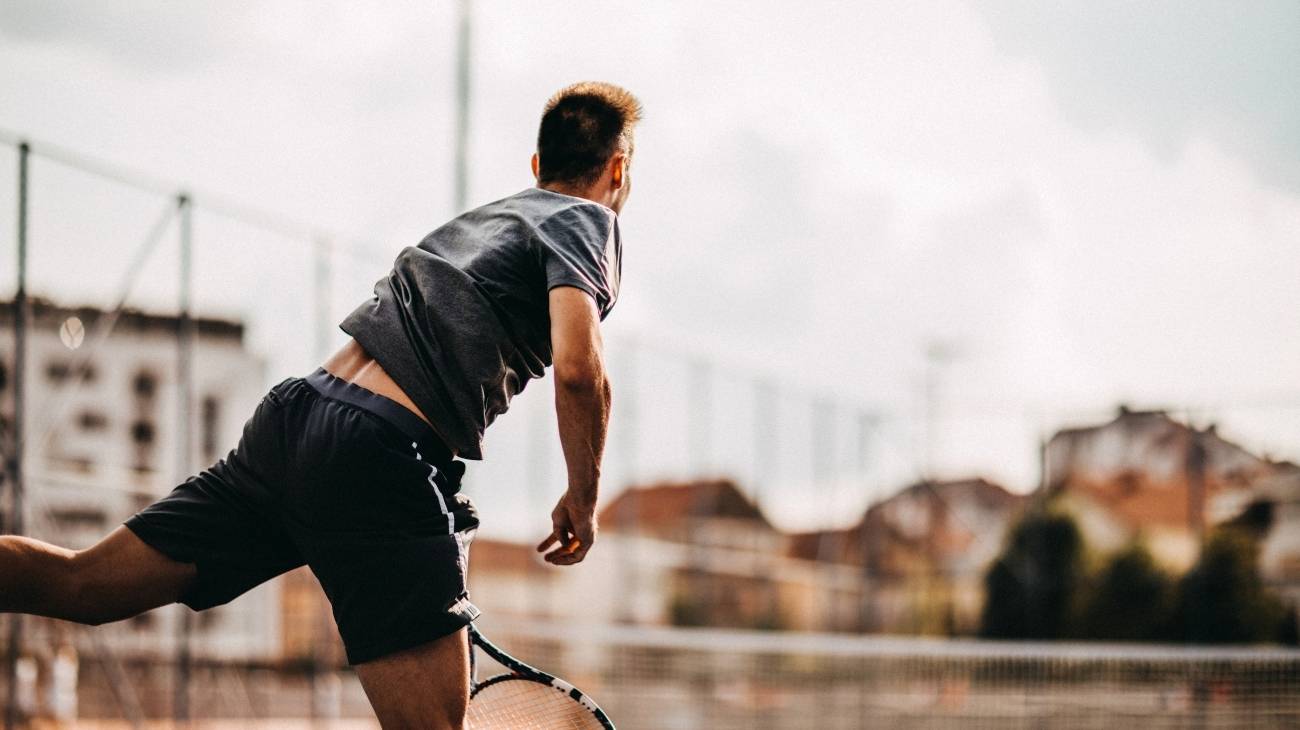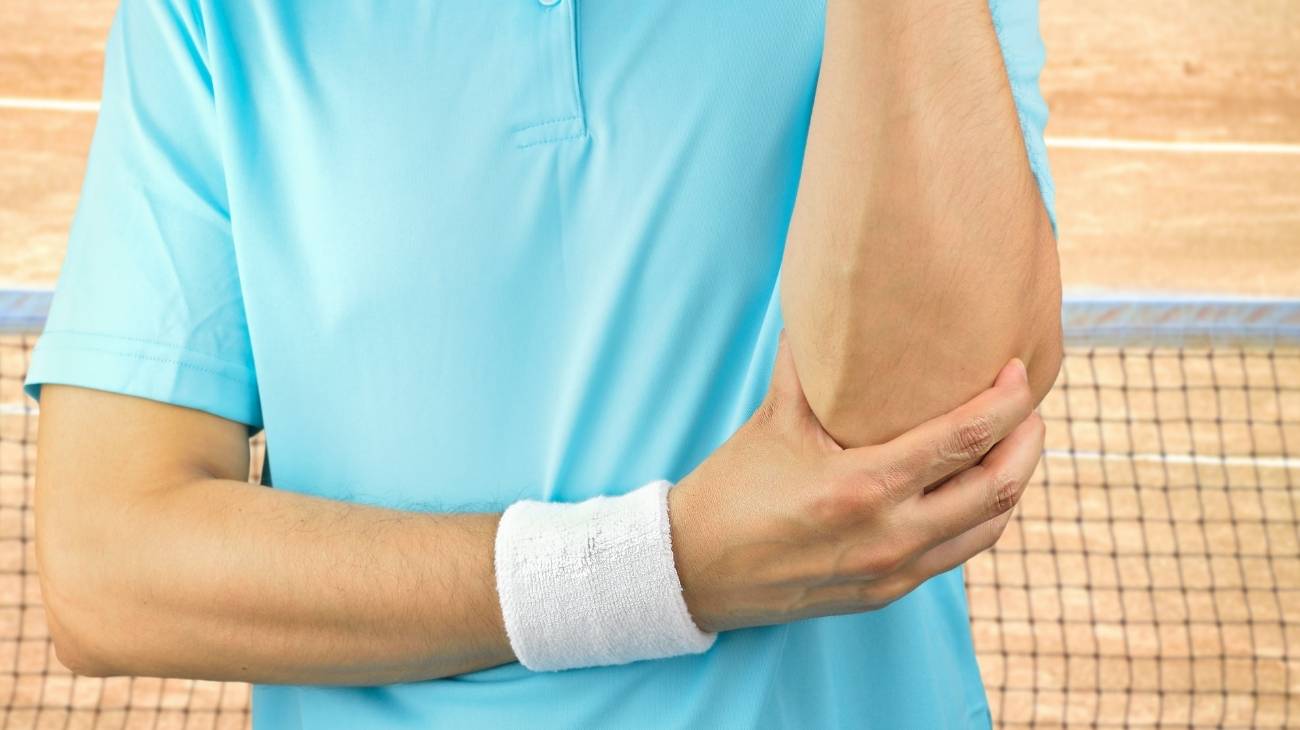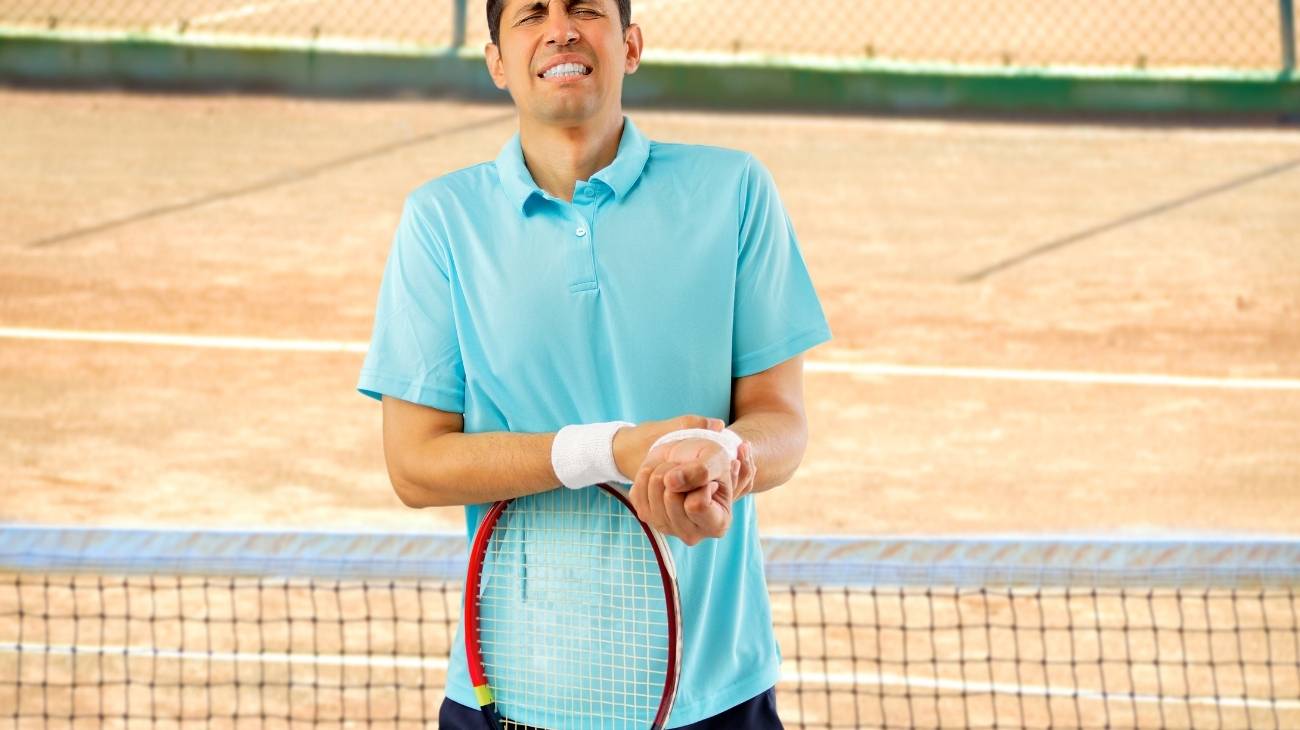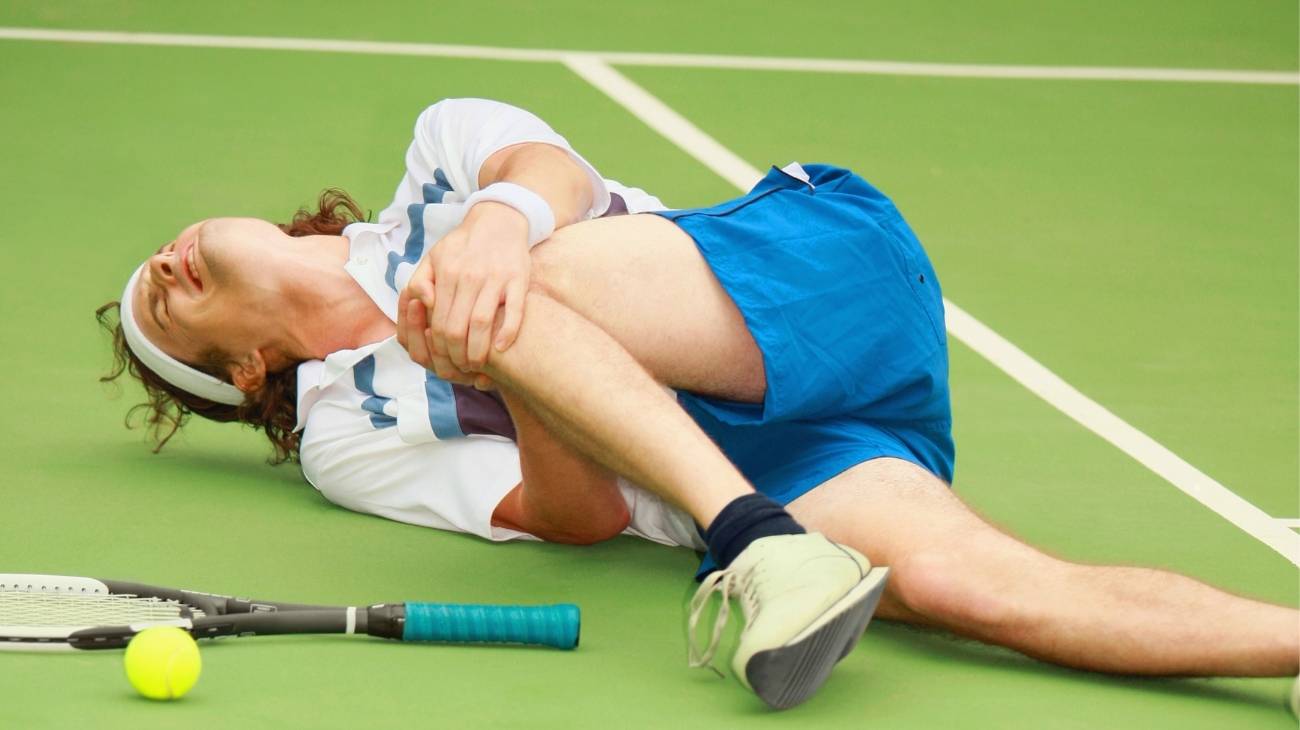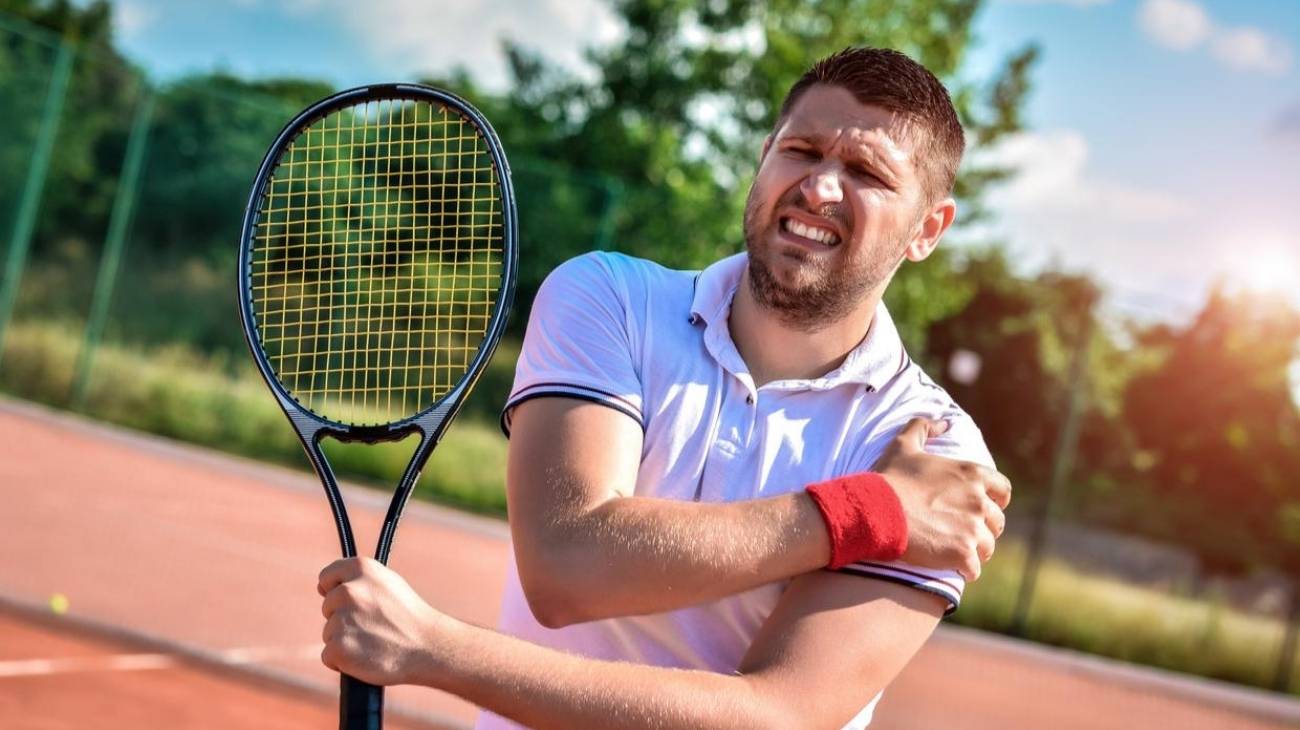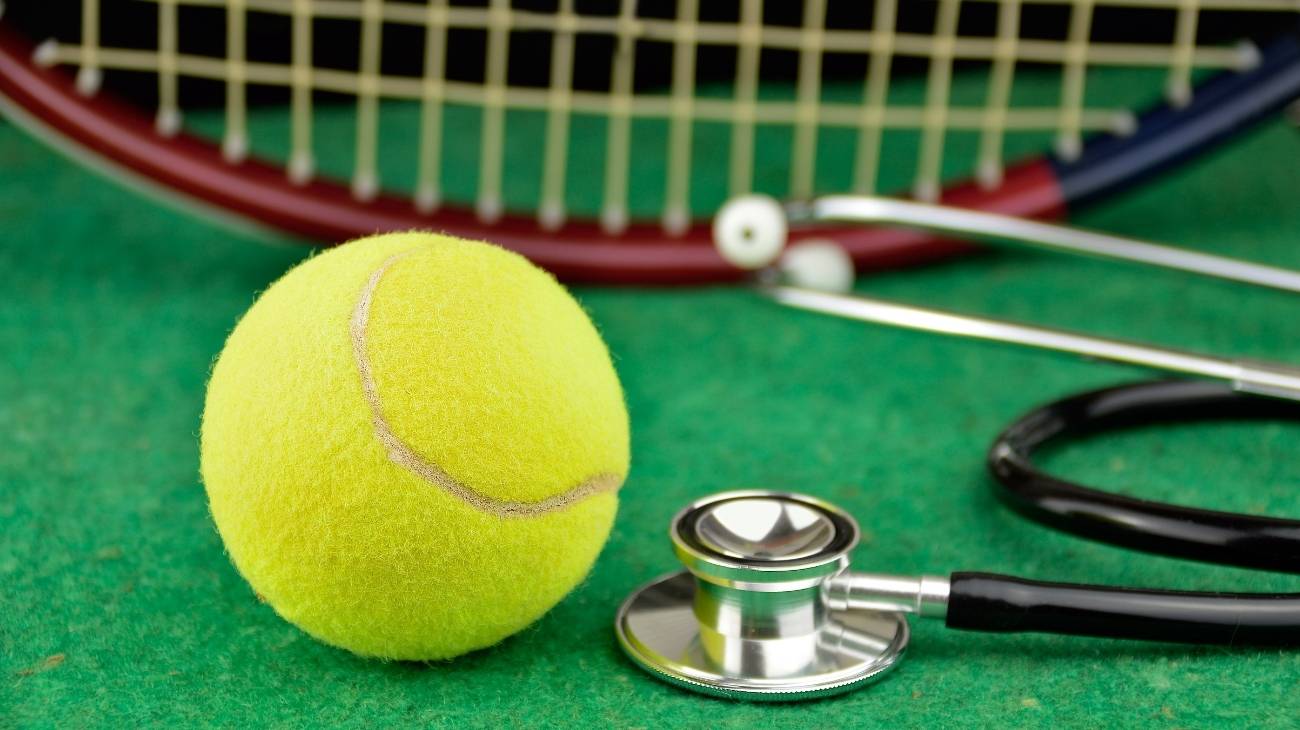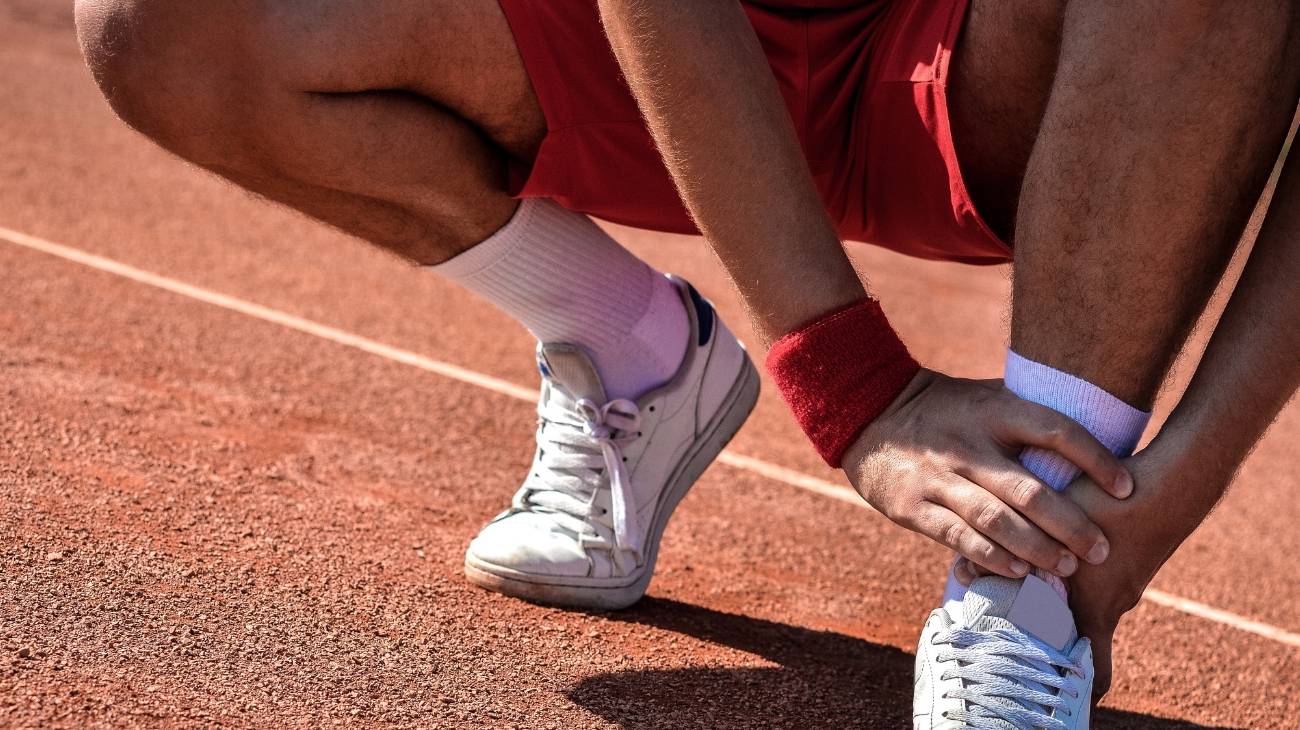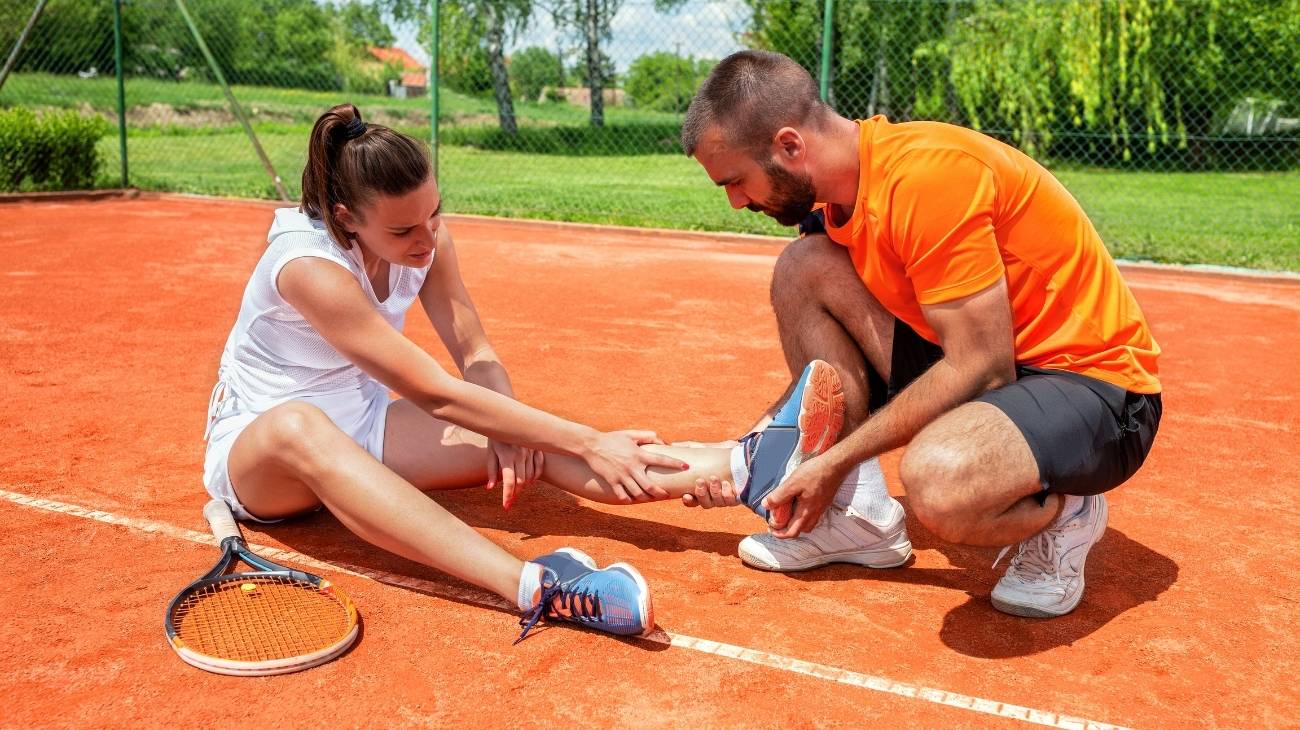Tennis is one of the most popular sports worldwide, but it is also one of the most technically demanding. It involves a continuous repetition of movements that generate an overload on the shoulder, elbows and wrists. It requires excellent physical preparation, and if this is not done, it is likely that some injuries will occur.
In this post we want to inform you about the main tennis injuries that professional and amateur athletes can suffer. Also, we want you to know the prevention measures and how to treat them. Join us to learn more about this excellent sport!
What are the most common types of injuries when we play tennis?
When playing tennis, injuries occur due to sudden changes in the rhythm of movements, excessive strain or trauma. As it is such a complete sport, all parts of the body are involved and therefore anyone can be injured. The most common areas for injury are the shoulder, elbow, wrist and ankle, these are your most frequent injuries:
Dislocated shoulder
The shoulder is one of the most affected parts in tennis because it has greater mobility and range of motion than any other joint. This injury is also known as tennis shoulder dislocation, generated by performing very forced positions.
In this case, when the arm is raised in external rotation and exercising maximum power of the stroke, it causes separation. The head of the humerus and the glenoid cavity of the scapula separate, generating the dislocation. This occurs more frequently in falls, direct hits, or sudden movements without proper training and technique.
Shoulder micro-instability
This is a consequence of repetitive injuries at the shoulder level and is very common among tennis players. It is considered an anatomical alteration of the shoulder joint and is also known as shoulder subluxations. It causes the upper portion of the humerus to move abnormally and to come out of the glenoid socket easily.
It tends to appear most often between the ages of 20 and 60 and in people with demanding sporting practices. Its main characteristic is that it generates subluxations or a sensation of the head of the humerus leaving and returning spontaneously. For this reason, it causes an unpleasant sensation of discomfort, a sign of a "dead arm" due to the impossibility of moving it and sometimes intense pain.
SLAP lesion
Its name derives from the English acronym "Labrum lesion from Anterior to Posterior". These are lesions that affect the insertion of the upper labrum of the joint between the humerus and the scapula called the glenohumeral. The labrum is a fibrocartilage that surrounds the glenoid cavity and is where the head of the humerus will fit and settle.
This injury is caused by falling on the shoulder with the arm extended or by repetitive throwing movements. Intense pain is generated in the shoulder especially when performing overhead movements. This causes instability, stiffness, weakness and a snapping sensation when moving the joint.
Lateral epicondylitis or tennis elbow
This is the most frequent pathology in tennis players, caused by an overload of the elbow joint. It is a very painful injury where inflammation and micro tears occur in the arm's extensor muscle fibres. It usually occurs when the proper techniques are not performed in the practice of tennis.
Its symptoms include burning or pain in the outer area of the elbow and muscle weakness for grip. They are often made worse by activity with the forearm such as shaking the arm, turning the wrist or holding the racket.
Wrist tendinitis
The wrist is mostly made up of tendons that connect the muscles to the bones. They are the ones that receive the impact of the repetitive movements that cause the impact of the tendons on the bones and other tissues. This is why the wrist of tennis players is one of the parts most susceptible to injury from overload, repeated trauma or degenerative processes.
The characteristic symptom of wrist tendinitis is severe pain in the wrist, which often worsens with movement. Also, there may be swelling, redness, crackling, snapping, limitation and weakness of movement.
Capsulitis in fingers
It is one of the most common hand injuries in tennis caused by racket impacts, balls, trauma and falls. It involves inflammation of the joint capsule, which is a membrane that surrounds the area where two or more bones meet. Its function is to cushion the impacts of movements by preventing the bones of the fingers from moving.
When the impact is greater than the finger capsule can withstand, it breaks, releasing the synovial fluid. This results in increased volume, pain and the inability to move the fingers. Although it is not such a serious injury, it usually generates a lot of pain and discomfort.
Lumbago
Low back pain is a common injury in tennis players and is mostly caused by mechanical causes. Hitting the ball with force requires a powerful impulse from the whole body from the feet to the hand. The lumbar area is also subject to very abrupt strains and rotational movements.
The lumbar region is not prepared for wide-ranging movements, especially rotary movements. The impact they generate damages the articular veneers of the vertebrae and in many cases the vertebral discs. This produces intense pain at the lumbar level which can be incapacitating and can radiate to the buttocks and legs.
Ruptured meniscus
The knees also suffer the impacts of tennis practices, with meniscus tears being one of the most frequent. Injuries arise after sudden movements of turning and extension at the knee, accentuated by the weight of the body. Generally, a break or tear occurs at the level of the meniscus which can be small cracks, partial or total ruptures.
Crushing injuries can also occur when falling on the feet with the knees extended. It is manifested by diffuse pain in the knees, an increase in volume and limitation of mobility to the extension. It causes a sensation of failure in the knees and a clearly audible snap when making a movement.
Injury of the anterior cruciate ligament of the knee (ACL)
Although the injury is not so common among tennis players, it can be a nightmare. This condition can be generated by stretching, tearing or rupturing the anterior cruciate ligament of the knee. This occurs mainly when making abrupt stops, sudden variations in direction or jumping and falling on your feet. You may feel a sharp clicking in the knee, severe pain, rapid increase in volume, limitation of movement and instability of the knee.
Jumper's knee
Also known as patellar tendinitis, an injury to the tendon that connects the kneecap to the tibia bone. The patellar tendon is responsible for working in conjunction with the knee muscles to allow running, kicking and jumping. Injury to this tendon occurs in the practice of sports that have a great impact on the knees, such as tennis.
The overloading of this joint by frequent and repetitive movements such as running and jumping generates microtubules at the level of the tendon. This causes loss of support and increased stiffness in the knee, intense pain when stretching the leg, sitting, jumping and bending.
Tear or rupture of the hamstrings
Tearing or breaking of the hamstrings is also one of the most common injuries in tennis. It is caused by movements such as running fast and making sudden, rapid starts or stops. These movements generate excessive stretching or tension of this group of muscles.
Its main cause is the lack of stretching of the muscles before starting any sport. This causes a sharp and sudden pain with a sensation of tearing or bursting at the back of the thigh. Bruising, increased sensitivity, swelling, weakness and inability to bear the weight of the leg may also occur.
Sprained ankle
Ankle sprains are caused by excessive stress on this joint and are the result of a sprain due to instability. The direct consequence is a stretching or tearing of the ligaments that provide stability and connection to the bones of the ankle. In tennis, the jumps with turns that tennis players make to gain more momentum originate later on.
Instability can overstretch the ligaments to the point of causing a slight stretch to a tear. The characteristic of a sprained ankle is pain during movement, increased volume, bruising, ankle instability and crackling.
Achilles tendonitis
It is a pathology or injury that causes inflammation and pain at the level of the Achilles tendon, specifically in the heel of the foot. The Achilles tendon is a fibrous band that joins the leg muscles to the foot bones. This connection allows you to stand on your toes, walk, jump and run.
It occurs in runners who suddenly increase or decrease the intensity of their runs. In the case of tennis, it occurs more often in people who usually play the sport only on weekends. It produces a mild pain in the back of the leg or above the ankle and stiffness in the mornings.
Plantar Fasciitis
One of the most common conditions that can occur in the practice of tennis or any sport. It is produced by the inflammation of a structure found in the foot called the plantar fascia. It connects the bones of the heel to the toes, forming the arch of the foot.
Inflation of the plantar fascia is caused by tension and excessive stretching generated by running or jumping. It is very common in people who are not accustomed to excessive stress or with deformities of the plantar arch without proper footwear. Severe pain occurs when standing, jumping or walking barefoot and there is a lot of sensitivity in the plantar arch.
Bone fractures
They represent the least frequent injuries in tennis, but that does not mean that they cannot occur. They occur when there are falls, blows, impacts on susceptible areas such as shoulders, elbows, wrists, hands, ankles, among others. When they occur, they are the injuries that most generate impediments to practicing tennis for the longest time.
They cause very intense pain accompanied by deformity of the affected limb or area. Also, it produces crackling or creaking in the joint or bone with the impossibility of making movements. It requires an emergency medical evaluation and immobilisation of the affected part.
Best products for tennis injury recovery
Bestseller
-
2 Ankle Compression Sleeve (Black/Gray)
£17,50 -
2 Ankle Compression Sleeve (Green/Navy)
£17,50 -
2 Ankle Compression Sleeve (Pink/Bordeaux)
£17,50 -
2 Elbow Compression Sleeve (Black/Gray)
£17,50 -
2 Elbow Compression Sleeve (Green/Navy)
£17,50 -
2 Elbow Compression Sleeve (Pink/Bordeaux)
£17,50 -
2 Knee Compression Sleeve (Black/Gray)
£17,50 -
2 Knee Compression Sleeve (Green/Navy)
£17,50 -
2 Knee Compression Sleeve (Pink/Bordeaux)
£17,50 -
2 Patella Knee Strap (Black/Gray)
£12,95 -
2 Patella Knee Strap (Green/Navy)
£12,95 -
2 Patella Knee Strap (Pink/Bordeaux)
£12,95 -
2 Tennis Elbow Brace (Black/Gray)
£12,95 -
2 Tennis Elbow Brace (Green/Navy)
£12,95 -
2 Tennis Elbow Brace (Pink/Bordeaux)
£12,95 -
Acupressure Mat and Pillow (Black/Gray)
£44,95 -
Acupressure Mat and Pillow (Green/Navy)
£44,95 -
Acupressure Mat and Pillow (Pink/Bordeaux)
£44,95 -
Acupressure Pillow (Black/Gray)
£21,52 -
Acupressure Pillow (Green/Navy)
£21,52 -
Acupressure Pillow (Pink/Bordeaux)
£21,52 -
Back Support Belt (Black)
£29,95 -
Back Support Belt (Green)
£29,95 -
Back Support Belt (Pink)
£29,95 -
Foot Massage Roller for Plantar Fasciitis (Black)
£17,50 -
Foot Massage Roller for Plantar Fasciitis (Green)
£17,50 -
Foot Massage Roller for Plantar Fasciitis (Pink)
£17,50 -
High Density Foam Roller for Muscle (Black/Gray)
£24,95 -
High Density Foam Roller for Muscle (Green/Navy)
£24,95 -
High Density Foam Roller for Muscle (Pink/Bordeaux)
£24,95 -
Ice Massage Roller Ball (Black)
£34,95 -
Ice Massage Roller Ball (Green)
£34,95 -
Ice Massage Roller Ball (Pink)
£34,95 -
Microwave Wheat Bag for Neck & Shoulder Pain Relief (Hearts)
£21,50 -
Microwave Wheat Bag for Neck & Shoulder Pain Relief (Oxford)
£21,50 -
Microwave Wheat Bag for Neck & Shoulder Pain Relief (Sport)
£21,50 -
Pack 2 in 1: Foam Roller High + Soft Density (Black/Gray)
£24,95 -
Pack 2 in 1: Foam Roller High + Soft Density (Green/Navy)
£24,95 -
Pack 2 in 1: Foam Roller High + Soft Density (Pink/Bordeaux)
£24,95 -
Shoulder Support Brace (Black)
£21,95 -
Shoulder Support Brace (Green)
£21,95 -
Shoulder Support Brace (Pink)
£21,95 -
Soft Density Foam Roller for Recovery (Black)
£24,95 -
Soft Density Foam Roller for Recovery (Green)
£24,95 -
Soft Density Foam Roller for Recovery (Pink)
£24,95 -
Trigger Point Massage Stick (Black)
£12,95 -
Trigger Point Massage Stick (Green)
£12,95 -
Trigger Point Massage Stick (Pink)
£12,95 -
Wrist Brace (Black/Gray)
£17,50 -
Wrist Brace (Green/Navy)
£17,50 -
Wrist Brace (Pink/Bordeaux)
£17,50
How can we prevent injuries when we play tennis?
Tennis is a very fun activity, however, it requires optimal physical conditions and the right techniques. Most injuries in this sport can be avoided if certain rules and recommendations are followed:
Warm-up
Tennis is a sport that requires a state of complete preparation at the start of any match or practice. This preparation process is known as warming up and generates important effects on the organism by conditioning it for the physical effort it will make. The main effect is to provide greater blood flow to the muscles by ensuring an adequate supply of oxygen. Also, better flexibility, especially at the level of the upper and lower limbs.
The following exercises should be carried out during warm-up:
- Jogging: Jogging is an exercise which conditions 70% of the body's musculature, which improves the athlete's physical condition. You can start with a gentle trot and increase the intensity to increase your performance.
- Resistance exercises: Subsequently, exercises should be carried out to improve the athlete's performance. You can combine exercises such as running, jumping rope, use of cables and pulleys and lifting your own body weight. In this way, cardiovascular and pulmonary resistance is gained.
- Gentle stretching: Stretching is essential for the muscles to obtain greater flexibility during sport. In tennis it is important to stretch from the muscles of the neck, to the ankle and to the foot.
Warming up is a stage that should last about 15 minutes. However, the time will depend on the intensity and duration of the activity to be performed. The precise moment is when the person starts to sweat, but does not yet feel tired.
Cooling
After practising the sport, it is also necessary to carry out appropriate cooling techniques to allow good recovery of the muscles. This maximises performance in subsequent practices and reduces the likelihood of looking like future injuries.
Ideally, 15 minutes should be taken after exercise for a gentle activity such as walking and stretching. Stretching is very important, especially for muscles that have been used in sport. In tennis, it is advisable to cool the muscles of the shoulder, arm, elbow, forearm, wrist and ankle tendons and spine.
The most recommended cooling exercises are:
- Jogging and light walking: You should start with a light jog that decreases in intensity until you reach a gentle walk. The idea is to gradually lower your heart rate until you reach a resting state.
- Lifting shoulders and arms: While doing the gentle walk you can lift your shoulders and arms above your head on several occasions. This helps the blood accumulated in the muscles to move along with other waste products of the muscle metabolism.
- Stretching and rotating movements: Stretching and rotating movements can be performed at the level of the trunk, legs and feet. This helps prevent muscle stiffness and numbness later on.
Among the benefits of cooling and stretching after any sport is to reduce muscle pain. This is important, especially the next day, as it considerably improves the body's flexibility and elasticity.
Equipment
Tennis undoubtedly requires the use of appropriate equipment, one could say that it is fundamental for any tennis player. It not only involves comfort in playing, but considerably prevents injuries. Appropriate equipment includes everything from sportswear and shoes to rackets and other clothing.
- Clothing: When starting practice it is very important to feel comfortable, so proper sportswear is essential. Tennis clothing has the characteristic that it must fit well to the body and offer freedom of movement. The fabric must be soft and comfortable and not generate friction on the skin. Also, it must be completely breathable, be able to absorb sweat and provide sufficient fresh air. The design must be appropriate, there are currently a variety of designs and colours.
- Tennis shoes: Shoes are an essential piece of equipment in the practice of tennis as they provide freedom of movement, comfort and prevent injuries. A good shoe helps you get a perfect grip on the court so you can reach every ball. In addition, they protect your feet, leg muscles and joints from future injuries during every game. To choose the right shoes you should look for stability, cushioning, traction, durability, lace, lightness and durability. Remember that tennis shoes must be able to withstand sudden changes in direction and provide a certain level of flexibility.
- Racquets: The racquet is the most important accessory for playing tennis on the court. There is a large stock of rackets on the sports market so choosing one is sometimes overwhelming. Most players tend to select the best selling racket they find in the shops. However, it is very important to know the characteristics to find the best and most suitable one. The first thing to take into account is the handle, it must generate a perfect connection between the hand and the racket. Also, you must look at the head, it is the size of the face of the racket and influences the control and acceleration of the ball. There are different sizes, the big rackets are for beginners and the small ones are for professional players.
- Tennis balls: Tennis balls also have an important influence on tennis practice. There are 5 models of tennis balls and their yellow colour gives them the necessary visibility when playing on the court. They are composed of a core that influences the weight, bounce and a layer of felt that provides durability and resistance.
Nutrition and hydration
Tennis is a very demanding sport and due to its high intensity characteristics it generates an accentuated caloric expenditure. For this reason, tennis players must maintain a very balanced and varied diet, adapted to the energy expenditure of the sportsman or woman. An adequate intake of nutrients keeps your muscles and ligaments in good condition and prevents future injuries.
Ideally, each sportsperson should have approximately 5 meals a day in a fractionated and very orderly manner:
- Carbohydrates: The consumption of carbohydrates is essential to provide the necessary energy. There are several options from this food group such as rice, oats, pasta, bread and quinoa. Also, from vegetable sources such as potatoes, legumes, fruits and vegetables. Intake should be in accordance with the demands of sporting activity. In light training between 5-7 grams per kilogram of body weight. In moderate to heavy training between 7-10 grams per kilogram of body weight.
- Proteins: Proteins are essential for repairing damage to the muscles. In combination with carbohydrates they promote adaptation and increase the effects of training. The main proteins are beef, poultry, fish, eggs, dairy products, nuts and pulses. The ratio should be 1.2 -1.4 grams per kilogram of body weight per day.
- Fats or lipids: These have an important function, as they provide energy. It is important that they are monounsaturated and polyunsaturated fats such as olive oil, nuts, blue fish and avocado. They should represent between 20 and 30% of the caloric intake of the diet.
How should a tennis player be fed? It is important that you know that the diet before each match must be rigorous, you can follow these recommendations:
- Feeding during each training session: Before each training session it is necessary to make a carbohydrate-rich food intake 2-3 hours before. For high performance training, between 30-60 grams per kilogram of body weight should be consumed, including a fruit or energy bar.
- Feeding during the match: Two days before the match it is best to make carbohydrate intakes between 7-10 grams per kilogram of body weight. Then 2-4 hours before the match, 2-4 grams of carbohydrates should be eaten per kilogram of body weight. It should be a meal that is high in carbohydrate, moderate in protein and low in lipids or fat. During the match, which can last 60-90 minutes, it is recommended to consume 60-90 grams per kilogram of body weight. Consumption of the food should be accompanied by isotonic drinks, sports bars and fruit.
- Food after the match: A scheme must be followed, within the 1st hour it must include hydration and adequate food. Hydration should be provided by recovery drinks based on sodium, hydrolysed protein and carbohydrates. Later, a solid food intake rich in carbohydrates, with a protein element that favours cell recovery, should be made.
And, where do we leave the hydration? Hydration is also important for a tennis player, like all sportsmen and women there must be a controlled intake of liquids. That's why it's important to hydrate yourself before, during and after each match.
- Hydration before the match: You should drink approximately 5-7 ml per kilogram of weight before the start of the match. This corresponds to 2-3 glasses of water 3-4 hours before the match. One glass can also be replaced by an isotonic drink and one hour before the start of the match 1 glass of water.
- Hydration during the match: It is advisable to drink 150-200 ml per kilogram of weight every 15-20 minutes. When physical activity exceeds 60-90 minutes, the water should be replaced with an isotonic drink to replace the electrolytes lost in sweat. Electrolytes are involved in the correct functioning of the muscles and in fatigue, so they must be taken into account.
- Hydration after the match: After each game of tennis, hydration should be continued, preferably with isotonic drinks and plenty of water.
Physical fitness
Tennis is a very demanding sport on a physical level and those who play it must be in optimum physical condition. However, tennis does not require a prototype of body shape. One can be an excellent tennis player and have different characteristics from other tennis players in terms of anthropometric measurements.
In professional tennis practice there has been a trend to select players with greater height. It has been established that an ideal height is approximately 185 cm. However, what really matters is the technique and gestures that each tennis player develops.
Physical preparation must be aimed at having well-developed upper and lower limbs. The main purpose is to achieve greater speed, ability to react, rapid changes in speed and direction. Also, special attention must be paid to neuromuscular coordination and to be able to play on different surfaces and in different environments.
Recovery therapies
Muscle recovery therapies are essential after any match or simply after tennis training. Performance and body development will depend largely on the quality and speed of muscle recovery. The faster the body recovers, the greater the ability to train again and the less likely you are to be injured.
Among the therapies for muscle recovery we have:
- Sports massage: This is a set of techniques that aim to recover the tissues and prepare them for future effort. In addition, they prevent future injuries and are specially designed for high performance athletes. They can be of various styles such as pre-competition, recovery and maintenance massages.
- Use of cold/hot therapies: Applying cold and heat to the muscles after high-performance sports training is one of the best options. Cold is an excellent muscle pain reliever, while heat improves circulation and relaxes tendons and muscles. The combination of cold and heat promotes the recovery of the muscles, balances the cardiovascular system and the autonomic nervous system.
- Use of compression clothing: Compression clothing is a type of sports clothing that serves to put pressure on the muscles during physical activity. In tennis it is very useful because it allows better blood circulation while training. In addition, it allows better muscular recovery by reducing fatigue and helping to avoid injuries considerably.
- Use of acupressure therapies: Acupressure is a therapy closely linked to acupuncture, with the difference that it is not performed with needles but by applying pressure. The manipulation is done with the hands and focuses on local and activation points, i.e. where there is pain. Its purpose is to improve the flow of energy, release blockages and allow a healthy, harmonious and balanced body state.
- Use of thermotherapy and cryotherapy: Thermotherapy treats muscle injuries and fatigue, achieving a real therapeutic effect on pain and an excellent relaxing effect. Its mechanism of action is through the vasodilatation caused by heat at a muscular level. Cryotherapy generates the effect of vasoconstriction, reducing pain and inflammation, and is useful in avoiding further damage to sports injuries.
How to apply RICE therapy to treat first aid injuries in tennis players?
RICE therapy is a medical care protocol that is designed to allow for adequate recovery after any injury. It is one of the simplest methods to use in the sports environment, especially in case of rehabilitation.
Over the years it has been updated and is called PRICE, but the RICE method is still the best known by all. In this case the first step has been included which would be Protection "Protection".
This protocol comprises a series of steps to avoid major damage to the area:
- Protection (P): In this, the affected area must be protected without completely immobilising it. Training or matches should be stopped immediately and any kind of movement that could worsen the injury should be avoided. An immobiliser should then be fitted, which may be a sling, joint support or brace.
- Rest (R): The area should then be kept completely rested, avoiding the usual movements. The purpose of this type of rest is to avoid stiffness and maintain the flexibility of the injured part. The time should be for 48 hours and must be combined with a functional bandage temporarily.
- Ice (I): Next, one of the most effective therapies to reduce pain and inflammation, cryotherapy, should be used. It starts by placing cold compresses or cold gel bags between 10-20 °C for less than 20 minutes. Six to eight applications can be made to the affected area during the day and it is important never to exceed 20 minutes.
- Compression (C): Compression allows a better return of blood to the heart and ensures greater stability, firmness of the affected part. It can be done with a bandage that offers the right pressure to reduce inflammation and allows normal blood circulation. The best option is to use an elastic bandage that allows the position of the tissues to be fixed, but without totally immobilising them.
- Elevation (E): All other steps must be combined with the elevation of the injured area or body part. The correct way to do this is by keeping the affected area above the heart, always generating greater venous return. It is best to perform it in moments of rest using a soft surface as a pillow.
Treating any type of injury using the PRICE method is very simple and beneficial. The combination of these stages guarantees that the tennis player can have a faster recovery without any sequelae.
When should we see a specialist for the treatment of tennis injuries?
When sports injuries occur in tennis that immediately make mobility or a rapid recovery difficult, they can be serious. This is why sportsmen and women must know how to recognise when they need to consult a doctor.
Serious injuries can generate the following symptoms:
- Significant increase in volume in the affected joint or area.
- Instability of a joint or limb.
- Inability to carry out movements normally.
- Impossibility to start or stand.
- Pain in the back that radiates to the arms or legs with numbness and loss of sensation.
- Pain that gets worse as the days go by and interrupts sleep or daily life.
Chronic injuries are overuse and generate these symptoms:
- Pain that worsens with activity, but when you rest it disappears.
- Slight swelling or increase in volume.
- Crunching of the joints when performing the usual movements.
- Weakness that reduces the capacity of the joint or limb to move normally.
References
- Kibler, W. B., & Safran, M. (2005). Tennis injuries. Epidemiology of Pediatric Sports Injuries: Individual Sports, 48, 120-137. https://www.karger.com/Article/Abstract/84285
- Pluim, B. M., Staal, J. B., Windler, G. E., & Jayanthi, N. (2006). Tennis injuries: occurrence, aetiology, and prevention. British journal of sports medicine, 40(5), 415-423. https://bjsm.bmj.com/content/40/5/415.short
- Dines, J. S., Bedi, A., Williams, P. N., Dodson, C. C., Ellenbecker, T. S., Altchek, D. W., ... & Dines, D. M. (2015). Tennis injuries: epidemiology, pathophysiology, and treatment. JAAOS-Journal of the American Academy of Orthopaedic Surgeons, 23(3), 181-189. https://journals.lww.com/jaaos/Fulltext/2015/03000/Tennis_Injuries__Epidemiology,_Pathophysiology,.6.aspx
- Nigg, B. M., & Segesser, B. (1988). The influence of playing surfaces on the load on the locomotor system and on football and tennis injuries. Sports medicine, 5, 375-385. https://link.springer.com/article/10.2165/00007256-198805060-00003
- Bylak, J., & Hutchinson, M. R. (1998). Common sports injuries in young tennis players. Sports medicine, 26, 119-132. https://link.springer.com/article/10.2165/00007256-199826020-00005
- Abrams, G. D., Renstrom, P. A., & Safran, M. R. (2012). Epidemiology of musculoskeletal injury in the tennis player. British journal of sports medicine, 46(7), 492-498. https://bjsm.bmj.com/content/46/7/492.short
- Chandler, T. J. (1995). Exercise training for tennis. Clinics in sports medicine, 14(1), 33-46. https://europepmc.org/article/med/7712556
- Nirschl, R. P. (1988). Prevention and treatment of elbow and shoulder injuries in the tennis player. Clinics in Sports Medicine, 7(2), 289-308. https://www.sciencedirect.com/science/article/abs/pii/S0278591920309364
- Eygendaal, D., Rahussen, F. T. G., & Diercks, R. L. (2007). Biomechanics of the elbow joint in tennis players and relation to pathology. British journal of sports medicine, 41(11), 820-823. https://bjsm.bmj.com/content/41/11/820.short
- Perkins, R. H., & Davis, D. (2006). Musculoskeletal injuries in tennis. Physical Medicine and Rehabilitation Clinics, 17(3), 609-631. https://www.pmr.theclinics.com/article/S1047-9651(06)00031-3/fulltext


























